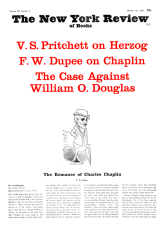In response to:
The Importance of Norbert Wiener from the September 24, 1964 issue
To the Editors:
May I, as the friend and publisher of the late Norbert Wiener, add a modifying footnote to Mr. Toulmin’s interesting essay in the issue of September 10.
It seems to me that in emphasizing the crucial implications in Wiener’s wartime work on anti-aircraft gun-pointing systems, Mr. Toulmin pays too little attention to the singlemindedness of Wiener’s mathematical work from the very beginning of his career. Since this single-mindedness has always seemed to me to be at the heart of Wiener’s genius, I should like to recall (though I am no mathematician) the substance of many conversations between us which may, I hope, clarify this point.
One of Wiener’s early projects was to supply a mathematical description of a physical phenomenon known as the Brownian motion. This process, which had until Wiener’s solution, presented an apparently insoluble mathematical puzzle, concerns the seemingly random influence of molecular activity on small particles suspended in a liquid. The puzzle was to find with what regularity, if any, the molecular activity agitated the suspended small particles, a problem roughly analagous, as I understand it, to predicting the outcome of a game of water polo played by a multitude of seals using a nearly infinite number of balls.
The similiarity between this problem and that of the self-correcting gun-pointer—which was to select and track a random target moving at unpredictable speeds and in no particular direction—is not, I think, hard to grasp. Wiener was, in effect, asking the gun to respond to the plane as he himself had responded, some years before, to the complex molecular activity of the Brownian motion—a connection which he himself was fond of pointing out. The problem, in both cases, was to distinguish the order implicit in apparently random activities. Perhaps too a psychoanalytically inclined reader will see in this recurring tendency the reflection of Wiener’s prodigious childhood, when, for whatever reasons, the boy set himself the task of organizing his experience in sophisticated patterns at an age when, for his contemporaries, the external world must still have seemed a blur.
This is not to say that Wiener wanted to reduce all experience to predictable simplicities. On the contrary, he had a horror of what, in thermodynamics, is known as the heat death—the state, at the end of time, in which all temperature is uniform and all the particles of the universe move at the same rate or, in other words, are heatless and motionless: the state in which structure and organization collapse, in which complex processes fall into confusion and nature returns to the uniform chaos in which it presumably began. For Wiener the universe at large seemed to be tending in such a direction. But life was a temporary enclave of complex organization moving, within this larger process, in a contrary direction. For Wiener death and simplicity were synonymous as were life and complexity.
Mr. Toulmin’s observation is well taken that Wiener’s contribution to the history of ideas was to reconcile (perhaps by ignoring it) Descartes’ distinction between mind and matter by concentrating on principles of organization common to them both. Another way of putting it might be that Wiener, by ignoring the distinction between pure and applied mathematics, devoted his mathematical career to the study of life itself and to its most highly organized state, the human mind, as unique, if temporary, mathematical processes within the vast, inanimate, and ultimately all-consuming universe.
Jason Epstein
New York City
This Issue
October 22, 1964



